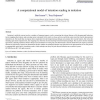Free Online Productivity Tools
i2Speak
i2Symbol
i2OCR
iTex2Img
iWeb2Print
iWeb2Shot
i2Type
iPdf2Split
iPdf2Merge
i2Bopomofo
i2Arabic
i2Style
i2Image
i2PDF
iLatex2Rtf
Sci2ools
RAS
2006
2006
A computational model of intention reading in imitation
Imitation in artificial systems involves a number of important aspects, such as extracting the relevant features of the demonstrated behaviour, inverse mapping observations, and executing motor commands. In this article we focus on how an artificial system can infer what the demonstrator intended to do. The model that we propose draws inspiration from developmental psychology and contains three crucial features. One is that the imitating agent needs repeated trials, thus stepping away from the one-shot learning by demonstration paradigm. The second is that the imitating agent needs a learning method in which it keeps track of intentions to reach goals. The third feature is that the model does not require an external measure of equivalence; instead, the demonstrator decides whether an attempted imitation was equivalent to the demonstration or not. We present a computational model and its simulation results, which underpin our theory of goal-directed imitation on an artificial system. c...
| Added | 14 Dec 2010 |
| Updated | 14 Dec 2010 |
| Type | Journal |
| Year | 2006 |
| Where | RAS |
| Authors | Bart Jansen, Tony Belpaeme |
Comments (0)

